Navigating Dubai: A Comprehensive City Map Guide
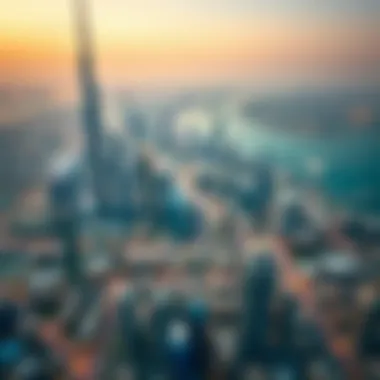
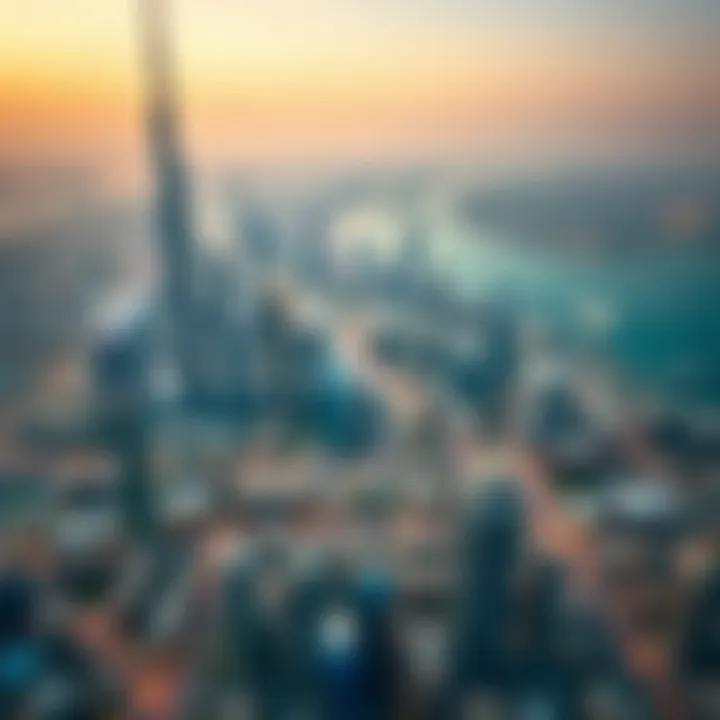
Intro
Dubai stands as a beacon of modernity and ambition in the heart of the Middle East. Known for its breathtaking skyline and cultural melting pot, navigating this vibrant city requires an understanding of its intricate tapestry of neighborhoods and landmarks. Whether you're an investor looking for a lucrative opportunity or a potential homeowner wanting to plant roots, knowing the lay of the land is indispensable. This guide will help illuminate the essential elements that define Dubai's geographic and cultural landscape.
In this article, we’ll explore prominent areas, vital resources, and community amenities, providing a map not only in a physical sense but also in a conceptual one for making informed choices in the real estate market. We’ll also delve into current trends shaping the property scene, alongside indispensable tips for potential buyers and investors.
Dubai is more than just a city; it's a phenomenon. Once a modest trading port, it has transformed into a global hub characterized by bold ambitions and unprecedented developments. Its neighborhoods are each distinct, showcasing everything from ultra-modern towers to quaint, historic districts. Hence, understanding these areas is akin to reading the city’s story—a narrative that continues to unfold.
Let’s dive deeper into the market insights that will equip you with the knowledge to navigate this dynamic environment.
Understanding Dubai's Geography
Dubai's geography serves as a pivotal foundation for understanding the city's development, culture, and real estate landscape. Its unique position along the southeastern shore of the Arabian Peninsula influences not just its climate but how urban life interweaves with the desert environment. Knowing the geographic nuances helps potential investors and residents make informed decisions, be it about property types or ideal neighborhoods.
An overview of Dubai's geography provides insight into its climatic conditions, which are characterized by extreme heat for most of the year. This factor affects urban design choices, energy consumption, and outdoor lifestyle decisions that are crucial for both residents and businesses alike.
One cannot ignore the fundamental importance of historical geographical attributes, as they directly influence modern urban planning and the city’s rapid expansions. Dubai’s topography has shaped its segmentation into various districts, each with its unique identity and appeal.
Understanding these geographic and climatic elements also opens the door to appreciating the diverse lifestyles that Dubai offers, from the cosmopolitan vibe of Downtown to the quieter, family-oriented feel in neighborhoods like Jumeirah.
The Location and Climate
Dubai is strategically located at the crossroads of Europe, Asia, and Africa, establishing it as a global hub for trade and tourism. This central positioning not only facilitates international business but also attracts millions of visitors. The proximity to major shipping lanes and air routes enhances its importance in logistics and transportation, further driving demand for real estate developments.
In terms of climate, Dubai is classified as arid, featuring long, sweltering summers and short, mild winters. Temperatures frequently soar above 40°C in the summer months, which can be challenging for outdoor activities. However, the milder winters are a double-edged sword, attracting tourists and new residents while posing considerations for lifestyle choices. Investors and homeowners should keep in mind how climate influences property decisions, from outdoor spaces to energy efficiencies.
Urban Expansions and the Evolution of the City
Dubai's rapid growth is nothing short of remarkable. From a modest fishing village in the 20th century to the dazzling metropolis of today, the city has witnessed several phases of urban expansion. Each stage reflects not just economic ambitions but also shifts in global real estate dynamics.
The construction boom of the early 2000s reshaped the skyline, characterized by iconic structures like the Burj Khalifa. Concurrently, this was the era when master-planned communities and luxury developments took center stage, fully transforming how urban living is conceptualized.
Investors now look beyond mere habitation; they consider lifestyle and amenities. For example, areas such as Dubai Marina sprang from ambition to create a waterfront lifestyle, while Business Bay focuses on commercial opportunities. As urban planning continues to evolve, keeping a pulse on these expansions offers vital insights for discerning investors.
These urban developments also raise questions about sustainability and innovation in construction methods, as Dubai pushes the boundary of what's possible in an ultramodern city. Knowing how these factors interplay can lend clarity to potential buyers as they navigate the vibrant real estate scene.
Key Districts of Dubai
Exploring the key districts of Dubai is fundamental for anyone looking to grasp the full charm of the city. Each neighborhood in this sprawling metropolis is like a piece of a puzzle, providing unique characteristics that contribute to the city’s overall landscape. Recognizing these districts aids not only in understanding the local culture and infrastructure but also serves as a compass for potential investors and residents scouting for their ideal spots. The districts vary significantly in style, purpose, and amenities, guiding buyers and residents toward well-informed decisions.
Downtown Dubai
Downtown Dubai stands as a premier example of modernity and luxury. This district boasts some of the most recognizable landmarks, drawing in millions of visitors each year. The Burj Khalifa, an iconic skyscraper, marks the skyline and acts as a beacon for residents and tourists alike.
Burj Khalifa and Surrounding Amenities
The Burj Khalifa is not just an architectural marvel but also serves as a vital hub for business and leisure. Located right at its foot, you can explore an array of amenities that enhance the urban experience, including lush parks, extravagant shops, and sophisticated restaurants. The observation deck on the 148th floor offers an unmatched view that underscores why this area is a top choice for real estate.
Among its many benefits, the accessibility to major transport links simplifies commutes, making it a prime location for executives and families. However, the cost of living here is on the higher side, potentially steering away budget-conscious buyers. This blend of luxury and convenience makes it a noteworthy mention in any discussion of Dubai’s real estate.
The Dubai Mall Experience
Neighboring the Burj Khalifa, The Dubai Mall is one of the most extensive shopping and entertainment centers globally. It houses not only fashion giants and artisanal boutiques but also features attractions like the Dubai Aquarium and an ice rink. The experience transcends that of a mere shopping trip; it’s a gathering spot for diverse cultural experiences and premium entertainment.
Key to its popularity is the variety it offers. You could spend an entire day here indulging in myriad dining experiences and family-friendly attractions. Yet, one should also consider the crowds, especially during weekends and holidays, which can diminish the overall experience for some. Nevertheless, its vibrant atmosphere and comprehensive offerings have solidified its position as an indispensable component of Dubai's allure.
Dubai Marina
Dubai Marina presents a contrasting yet equally compelling face to the cityscape. This area is characterized by its luxurious waterfront developments, perfect for those looking for premium living paired with stunning views of the marina and beyond.
Marina Walk and Lifestyle Offerings
Marina Walk is a delightful promenade that stretches along the waterfront, lined with restaurants, cafes, and shops. The leisurely stroll here is coupled with lively buskers and events that breathe life into the atmosphere. The centrality of this walk to the community experience makes it highly sought-after for both dining and leisure.
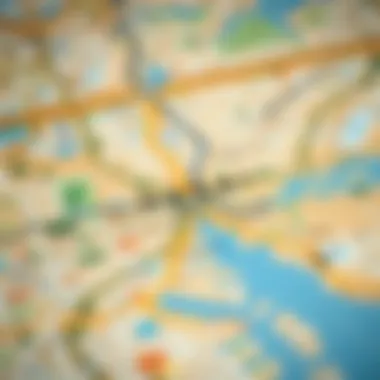

The unique feature of Marina Walk is its blend of luxury and relaxed lifestyle, making it ideal for singles and families alike. However, with growth in popularity, congestion can become a real issue, especially during peak hours.
Trends in Luxury Residential Developments
The residential landscape at Dubai Marina has evolved significantly in recent years, with ongoing trends moving towards upscale living. New developments often feature amenities like rooftop pools, gyms, and concierge services. This influx of luxury options makes it a hotspot for investors looking to capitalize on the ongoing demand for high-end living space.
The challenge here can be the saturation of the market; investors must be discerning about their choices. Yet, this urban growth indicates a promising future for property values, making it a sector worth monitoring closely.
Jumeirah
Jumeirah is often synonymous with leisure and luxury, offering some of the most desirable beachfront properties the city has to offer. This district blends the appeal of stunning coastal views with a laid-back lifestyle.
Beachfront Properties
The beach lifestyle in Jumeirah is unparalleled, making it ideal for those who prioritize outdoor living. Homes here often come with direct beach access, creating a serene atmosphere wrapped in the soothing sounds of the sea. The allure of pathway strolls and ocean activities is unmistakable.
However, the drawback can be the hefty price tag associated with these properties. They attract a high-end market, making it less accessible for those on tighter budgets. Ultimately, if you desire coastal life paired with luxury, this area should be on your radar.
Hotel and Resort Offerings
Jumeirah is home to several world-class hotels and resorts, offering extraordinary facilities and services. Establishments like the Burj Al Arab offer more than just accommodation; they promise a luxurious experience that is hard to match. This has made the district popular among tourists seeking opulence on their vacation.
The strategic advantage for real estate investors lies in the strong rental demand from vacationers. On the flip side, reliance on tourism can bring fluctuations in the rental market. Assessing the broader implications of this trend is vital for potential buyers.
Business Bay
As one of the fastest-growing commercial hubs, Business Bay exemplifies Dubai's spirit of enterprise and dynamism. The district houses a multitude of corporate offices and retail outlets, making it a nerve center for business activity.
Commercial Real Estate Insights
The commercial properties here are flourishing, with many multinational companies choosing to set up shop in this well-planned area. The blend of advanced infrastructure and strategic location near Downtown attracts a well-heeled clientele seeking office space.
Among the benefits of investing here is the expected increase in property value as Dubai continues to develop. Yet, potential investors should consider the variation in rental demand based on economic shifts. As a key player in Dubai's economic landscape, Business Bay warrants detailed examination.
Future Development Projects
Business Bay is in a constant state of evolution, with a plethora of development projects underway aimed at enhancing its status as a leading business hub. The upcoming residential and commercial projects promise to elevate property standards and introduce more amenities, benefiting the overall real estate market.
The unique feature of these projects is their potential to attract a diverse range of businesses and families to the area. However, one must remain aware of the effects construction and development can have on the surrounding community and infrastructure. Staying informed is critical for navigating investment opportunities here.
Al Quoz
Al Quoz stands out as a vibrant mix of art, culture, and industry. This district represents the city’s historical roots while embracing contemporary culture, making it a fascinating area to witness transformation.
Art and Culture Scene
Al Quoz has gained recognition as the heart of Dubai's arts community, highlighting galleries, studios, and art events throughout the year. This cultural hub attracts artists and enthusiasts, offering a platform for both emerging and established talents to showcase their work.
What makes it especially appealing is the integration of art into everyday life, with many cafes and shops reflecting local creativity. However, one challenge is the limited commercial real estate options for galleries and studios, posing a hurdle for new entrants. Investors would need to consider these aspects when assessing opportunities.
Industrial to Residential Transition
The transformation of Al Quoz from an industrial area to a lively residential and artistic community illustrates Dubai's adaptability. New residential projects highlight modern living in close proximity to cultural sites, appealing to creatives and families alike.
Though this evolution has created exciting investment opportunities, it also raises questions about zoning laws and infrastructure changes. Keeping informed and adapting to these shifts is essential for making sound investment decisions in this evolving landscape.
Transportation Infrastructure
Transportation infrastructure is the backbone of any vibrant city, and in Dubai, it is especially critical to understanding how residents and visitors navigate this bustling metropolis. This section delves into the various components of Dubai's transportation framework, highlighting the significance of efficient road systems, metro connectivity, and alternative public transport options. Each element serves not only to ease mobility but also to drive economic growth and tourism, making them essential for anyone considering life on this dynamic city.
Road Networks
The road networks in Dubai are expansive and meticulously planned, facilitating smooth travel across the city. With wide boulevards and tunnel systems, driving in Dubai often feels like gliding through an urban oasis. The roadways connect key districts like Downtown Dubai, Dubai Marina, and Jumeirah seamlessly, enabling quick commutes which can impact business and lifestyle positively. The well-maintained roads support an impressive volume of vehicles, which is crucial given the increasing population and number of tourists each year.
However, as the roads expand, so do traffic concerns, especially during peak hours when gridlock can be common. This has led to initiatives focused on smart traffic management solutions. For example, the city utilizes intelligent traffic signals and real-time monitoring systems to ease congestion and improve flow.

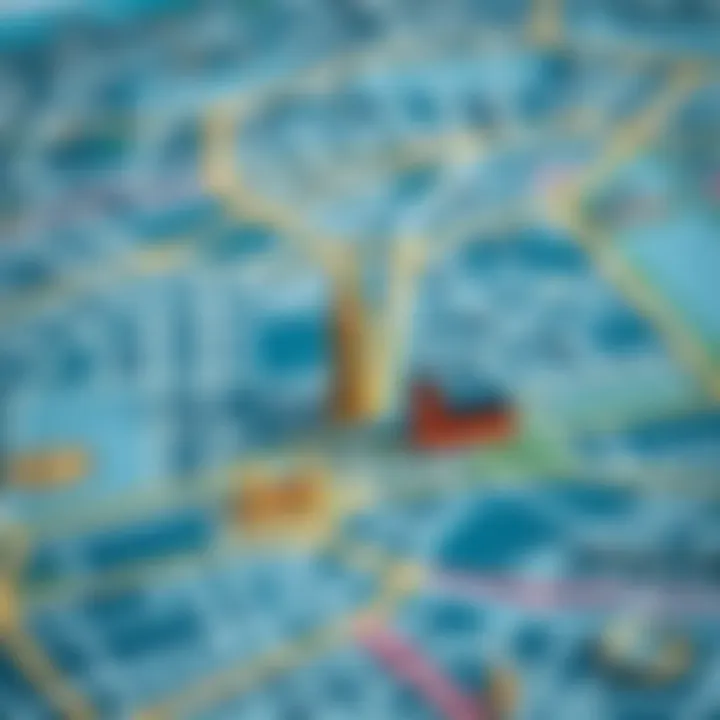
Metro System Overview
Dubai's metro system represents a significant advancement in the city’s transportation landscape. With two operational lines—the Red and the Green—this system is not only reliable but also serves as a cost-effective means of public transit.
Line Connectivity
A key highlight of Dubai's metro system is its extensive line connectivity. It facilitates travel from one end of the city to another with minimal hassle. The lines connect main hubs like the airport, shopping areas, and business districts effectively. This is especially beneficial for tourists and newcomers, who might not yet have their bearings in the city.
One unique feature of this connectivity is the direct link to major attractions such as the Burj Khalifa and The Dubai Mall from the metro stations, making it easy for visitors to hop from one landmark to another. Although some areas remain outside the metro’s reach, ongoing expansions aim to include additional districts, which will bolster connectivity. This growth is a testament to Dubai's commitment to evolving its transit systems.
Stations and Accessibility
The stations in Dubai's metro system are designed with accessibility in mind. Each station is equipped with elevators and ample signs in multiple languages, making them user-friendly for everyone, including those with disabilities. This inclusive approach shows Dubai’s commitment to accommodating all residents and visitors, aligning with its image as a global city.
One characteristic worth noting is the cleanliness and efficiency of the stations. It’s common to find security staff monitoring activities, which contributes to passengers feeling safe while using the metro. However, as the metro grows in popularity, the need for expansion and maintenance of these stations will likely become a pressing concern.
Public Transportation Alternatives
While the metro is a shining star in public transport, Dubai offers a range of alternatives to accommodate varying transportation needs.
Buses and Taxis
Buses and taxis form an integral part of Dubai's transport options. The bus fleet is extensive and serves various routes across the city, filling gaps not covered by the metro. Buses run relatively frequently, and they are an affordable choice for many residents. However, they can be less comfortable than the metro due to congestion at peak times.
Taxis, on the other hand, are quite prevalent, offering door-to-door services. They are generally clean and well-regulated, with transparent pricing and the possibility of hailing them via smartphone apps. The downside, however, is that during rush hour or weekends, it might take longer to get a taxi, leading to longer wait times.
Ride-Sharing Services
Ride-sharing services like Uber and Careem are also popular in Dubai. These services have made commuting more convenient, especially for short distances or when public transit seems cumbersome. The flexibility of being able to book a ride instantly and the variety of vehicle options at different price points appeal to many users.
A distinct feature of ride-sharing is the ability to track your ride in real-time, enhancing safety and convenience. However, surge pricing during peak hours can deter some from relying solely on this mode of transportation. Despite this, the growing trend of adopting ride-sharing reflects changing attitudes towards mobility in urban spaces.
Real Estate Trends and Insights
The real estate market in Dubai is a vibrant and dynamic sector. It plays a key role in the broader economic fabric of the city. Understanding the trends and insights of this market is crucial for anyone looking to invest or relocate here. Current dynamics, emerging opportunities, and risk assessment strategies all contribute significantly to the landscape of real estate.
Current Market Dynamics
Dubai's property market has seen shifts over the past decade, characterized by a blend of rapid development and fluctuating economic conditions. Since the global financial crisis, the city has rebounded, showcasing resilience in attracting foreign investments. Recent trends reveal a steady increase in property values across various sectors. The luxury segment, for instance, continues to thrive, largely due to appealing tax regulations and ongoing infrastructural improvements.
Moreover, the rise of off-plan properties has stirred buyer interest, often seen as a strategic entry point into the market. These properties often offer advantageous payment plans, making them attractive for investors looking at long-term gains. However, prospective buyers should keep a close eye on market fluctuations and policy changes that could impact property values.
Investment Opportunities in Emerging Areas
Potential Growth Sectors
As Dubai constantly evolves, certain sectors emerge as advantageous choices for investors seeking growth. Areas like Dubai South and Dubai Silicon Oasis are gaining traction for their innovative frameworks and infrastructural investments. The Dubai South development, for instance, encompasses the new airport and logistic hubs, which underpins its potential as a thriving residential and commercial area.
Investors often find these areas appealing due to several factors. The affordability of properties here compared to more established areas is a key characteristic. Furthermore, these sectors are backed by the government’s vision, promising significant development which can lead to property value appreciation. However, potential investors should be aware of the inherent risks associated with new developments, such as delays and changing market sentiments.
Risk Assessment Strategies
Investment in emerging areas comes with its own set of challenges. This necessitates well-thought-out risk assessment strategies. Understanding the local market trends and demographic shifts can be beneficial. Investors are advised to conduct thorough due diligence before committing to any property. Key characteristics of successful strategies include diversification of investment across different property types and geographic locations.
Further, utilizing market analysis tools and seeking expert advice can provide deeper insights into potential pitfalls. Investors should also consider the liquidity of their assets, ensuring they are not locked into properties that may not yield immediate returns. Understanding these dimensions improves decision-making and mitigates the risk involved in seeking more lucrative real estate opportunities.
"Investing in the right sector at the right time can turn the tide in your favor. It’s all about being informed and prepared."
In summary, staying abreast of current market dynamics while identifying potential growth sectors and establishing robust risk assessment strategies is essential for navigating Dubai's real estate landscape effectively.
Cultural Landmarks and Attractions
Cultural landmarks and attractions in Dubai are not just points of interest; they are pivotal in revealing the essence of this vibrant metropolis. Each monument and market not only serves as a visual feast but also tells a story of the city's rich history and its dynamic evolution over the years. These sites offer a blend of modern innovation and tradition, attracting both residents and tourists seeking a deeper understanding of the UAE's heritage. Moreover, they play a crucial role for investors, homeowners, and tourists alike, indicating the cultural vibrancy that enhances property value and quality of life.
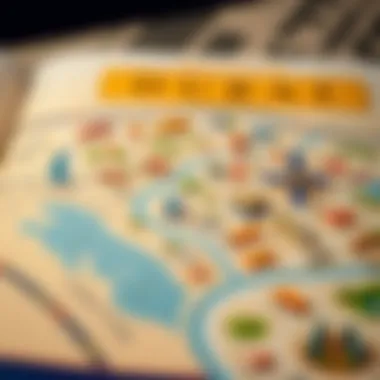

Iconic Structures
The Burj Al Arab
The Burj Al Arab, often dubbed as the world's only seven-star hotel, stands as a symbol of luxury and architectural prowess. Its sail-shaped silhouette captures the attention of anyone visiting the coastline. This landmark is not only a spectacular place to stay, but also serves as a hub for high-end dining experiences, offering guests exquisite culinary delights paired with breathtaking views.
Another notable aspect is its exclusivity; only hotel guests and those with reservations at its restaurants can venture inside. This adds an element of allure, positioning the Burj Al Arab as a desirable choice for those seeking a taste of lavish hospitality. Its luxurious suites and personalized service, coupled with its striking design, make it a major draw for high-net-worth individuals looking to invest in prime real estate.
While the hotel is frequently celebrated, it must be noted that its high price point can alienate many potential visitors and residents. Still, its unmatched reputation continues to fuel interest in surrounding locales, increasing property desirability in nearby areas.
The Palm Jumeirah
The Palm Jumeirah is a remarkable feat of engineering and a quintessential representation of Dubai's innovative spirit. Shaped like a palm tree, this man-made island boasts some of the most luxurious residential properties and resorts in the world, including the iconic Atlantis, The Palm. Its strategic layout and award-winning design have made it a beacon of opulence and a sought-after investment opportunity in the real estate sector.
This landmark is characterized by its picturesque beaches and vibrant nightlife, attracting affluent buyers looking for both vacation homes and long-term investments. The accessibility of beachfront properties enhances its allure, providing a lifestyle that combines leisure with luxury.
Yet, with investment opportunities come challenges. The premium pricing of properties can deter lower-budget buyers, creating a confined market segment. Nonetheless, the continuing development in and around The Palm is indicative of its strong potential for growth, making it a significant area for investors to consider.
Traditional Markets and Souks
Experiencing Local Culture
Experiencing local culture is undeniably central to truly understanding Dubai. Visiting traditional markets, or souks, allows newcomers and seasoned residents alike to immerse themselves in the rich tapestry of Emirati heritage. These bustling markets, such as the Gold Souk and Spice Souk, offer an array of artisanal goods, colorful spices, and local textiles that reflect the region's historical trade routes.
What sets these markets apart is their authenticity. Rather than the polished allure of modern shopping malls, these souks give a raw glimpse into daily life and the cultural practices of the Emirati people. Visitors often find themselves engaging with local traders and artisans, which adds a personal touch to the shopping experience. This connection to the local culture can ultimately enhance the residential appeal of the surrounding areas, making it a desirable location for potential buyers looking for community and character.
However, navigating these vibrant spaces requires an appreciation for bargaining, as prices are often not fixed. This can be both an advantage for savvy shoppers and a challenge for the unaware. Nevertheless, the atmosphere and experiences offered at these souks are irreplaceable commodities that significantly enrich the city’s cultural landscape.
Shopping and Dining Options
Shopping and dining options in Dubai are as diverse as they are plentiful. The mix of high-end boutiques, global brands, and local artisanal shops across the city caters to a variety of tastes and budgets, making it an appealing choice for both residents and tourists. With opportunities ranging from gastronomic delights in world-renowned restaurants to casual bites at local food stalls, the culinary scene reflects the melting pot that Dubai is.
The key characteristic of this aspect of Dubai's landscape is the availability; whether you seek a luxurious experience or a more casual meal, there's something for everyone. This rich variety not only adds flavor to the daily life but also enhances the investment appeal of nearby real estate, as the vibrancy and convenience attract residents.
That said, the overwhelming number of choices can sometimes lead to dissatisfaction among diners and shoppers alike, especially with the wide spectrum of quality. Monitoring consumer experiences is essential for buyers and investors to grasp the market dynamics in various neighborhoods. Overall, the culinary and shopping experiences provided are invaluable assets to the cultural narrative that makes Dubai unique.
Living in Dubai: A Practical Guide
Living in Dubai presents a unique blend of modernity and tradition, drawing people from all walks of life to experience its vibrant culture and stunning skyline. This section serves as a helpful guide for those considering making Dubai their home. Understanding the living conditions here is crucial not just for potential residents, but also for investors looking toward long-term rental opportunities.
Choosing the Right Neighborhood
Choosing the right neighborhood in Dubai can feel like finding a needle in a haystack, given the vast diversity of its districts. The decision impacts not just daily commute and lifestyle but also rental or investment returns.
Factors to Consider
When it comes to Factors to Consider, several elements should be evaluated before making a choice. These elements include proximity to work, ease of access to public transport, quality of education institutions, and recreational amenities.
For instance, areas like Dubai Marina and Downtown Dubai are vibrant and close to entertainment but might come with a higher price tag. Conversely, neighborhoods like Al Quoz or Jumeirah Village Circle might offer cheaper options with family-friendly environments.
Unique features of this aspect involve the variety of available living options that cater to both single professionals and families alike. One downside to consider is occasionally lengthy commute times caused by traffic surges, especially during peak hours.
Personal Preferences and Lifestyle Needs
Personal preferences play a significant role in shaping the choice of living arrangements. Personal Preferences and Lifestyle Needs encompass hobbies and daily routines that may dictate whether a more tranquil or bustling environment is desired.
For example, if one enjoys an outdoor lifestyle, areas like Jumeirah or Dubai Marina might be appealing due to their promenade walks and beach access. On the other hand, those who value a quieter neighborhood might opt for places like Arabian Ranches, which offer green spaces and a community feel.
The unique feature of this aspect is the potential for personalized living experiences, shaping not just the environment but overall life satisfaction in the city. One potential downside lies in choosing a neighborhood that does not offer adequate amenities or social interaction for expats or families.
Cost of Living Overview
The Cost of Living Overview is a critical factor in determining the feasibility of residing in Dubai. This overview highlights the essential expenses including housing, groceries, transportation, and schooling.
Housing, while oftentimes expensive, can vary dramatically depending on location. For example, renting an apartment in Dubai Marina can run upwards of 10,000 AED monthly, whereas neighborhoods like International City might start around 3,500 AED.
Transportation is relatively affordable, especially with public transport options like the metro and buses, which can help offset living expenses.
Ultimately, the cost of living is influenced by individual lifestyle choices, such as dining out frequently or using personal vehicles instead of relying on public transport.
"Understanding your financial commitments is key to enjoying life in one of the world's most dynamic cities."











